Intel Broadwell Architecture Preview: A Glimpse into Core M
by Ryan Smith on August 11, 2014 12:01 PM ESTPutting It All Together: Low Power Core M
So far we’ve discussed Broadwell’s architecture on a broad basis, focusing on features and optimizations that are fundamental to the architecture. However to talk about the Broadwell architecture is not enough to fully explain the Core M itself. Though many of Core M’s improvements do come from Broadwell, Intel has also made a number of alterations to everything from the CPU packaging to the process node itself specifically for Core M. It’s the resulting combination of these factors that has allowed Intel to iterate on Broadwell-Y over Haswell-Y, and why Intel is so confident in Broadwell-Y’s capabilities and suitability for mobile form factors.
When it comes to building and configuring Core M, Intel likes to refer to their efforts as the “Fanless Challenge,” reflecting the fact that their biggest goal with Core M is to comfortably get the processor in to 10” tablets under 10mm in thickness that are passively cooled. A big part of getting into such a device is meeting the heat dissipation limitations of the form factor – a 10” tablet under 10mm would require a sub-5W SoC – which is where a lot of Intel’s engineering efforts have gone. Broadwell’s performance optimizations, the GPU optimizations, GPU duty cycling, and the 14nm process all contribute to getting a Core CPU’s power consumption down to that level.
But even that’s still not enough, and for Core M Intel went so far as to give Broadwell-Y its own die and design a low-power optimized version of their 14nm process just for it. This variant is designed to further reduce power consumption by optimizing the resulting transistors for lower power, lower voltage, lower clockspeed operation. By doing this Intel was able to further reduce power consumption in all of the major areas over what would be a traditional 14nm Intel process.
In the resulting 14nm Broadwell-Y process, voltage, capacitance, and leakage were all improved over the traditional 14nm process. Capacitance was reduced by 15%, minimum operating voltages by 10%, and leakage was improved to the point that it reduced SoC power consumption by 10%. The combination of all of these factors serves to significantly lower power consumption over what Intel’s traditional 14nm process would provide.
Working in concert with Broadwell-Y’s 14nm process, Intel has made a number of other changes to further reduce power consumption. Some of these are reflected in Broadwell’s overall design and others are unique to Broadwell-Y, such as using a lower TjMax for Broadwell-Y. By reducing the maximum operating temperature of the chip Intel has been able to realize further power savings by further reducing voltage and decreasing the maximum amount of temperature-dependent leakage the SoC will experience.
Meanwhile Broadwell-Y’s partner in crime, the on-package PCH, has received its own optimizations to reduce power consumption on the SoC’s total power consumption. The PCH itself is not much of a power hog in the first place – it’s still made on Intel’s 32nm process for this and cost reasons – but with such a strong focus on power consumption every watt ends up counting. As a result the Broadwell PCH-LP has seen optimizations that cut its idle power consumption by 25% and its active power consumption by 20%. Further improvements to the PCH’s monitoring hardware also mean it’s more responsive and can be controlled to a finer degree than the Haswell PCH-LP, and Intel has upgraded to a faster audio DSP to improve performance and reduce power consumption there as well.
Feeding all of that silicon in turn is Intel’s second generation Fully Integrated Voltage Regulator (FIVR), which further builds off of Intel’s other optimizations. The 2nd gen FIVR has been tuned for Broadwell-Y’s lower voltages, making the FIVR itself more efficient when delivering power at those voltages. To accomplish this Intel has implemented non-linear vDroop control, which is designed to better control the voltage when workload changes would cause voltage overshoots that waste power. And when even the 2nd gen FIVR isn’t efficient enough, this latest FIVR offers a second mode (LVR Mode) for low voltage/workload situations where the FIVR can be partially bypassed to reduce the FIVR’s power consumption.
Interestingly Broadwell-Y also sees the voltage regulation inductors redesigned and relocated in both the name of power efficiency and space efficiency. We’ll get to the case of space efficiency in a moment, but for power efficiency the new 3D inductors (3DLs) have been placed on the underside of the package, allowing the use of more efficient inductors that waste less power.
This brings us to the final element of Intel’s power optimization efforts, which involve further adjustments to turbo boost as part of Intel’s “hurry up and go to sleep” motto. New for Broadwell-Y is a 3rd power state, PL3, which allows for even greater turbo boosting, but for only a very limited period of time – on the order of milliseconds. PL3 represents the maximum amount of power the device battery can deliver, and while it’s okay to reach this value sparingly, PL3 is a fast drain that is very hard on the battery. The existence of PL3 in this case is as much for battery protection as it is for performance; it allows devices to tap into PL3 power levels on occasion, all the while allowing PL2 (the regular burst limit) to be defined at a safer value below the battery’s limit. Put another way, by knowing PL3 devices know how to stay farther away from it, which in the long run is what’s best for battery reliability.


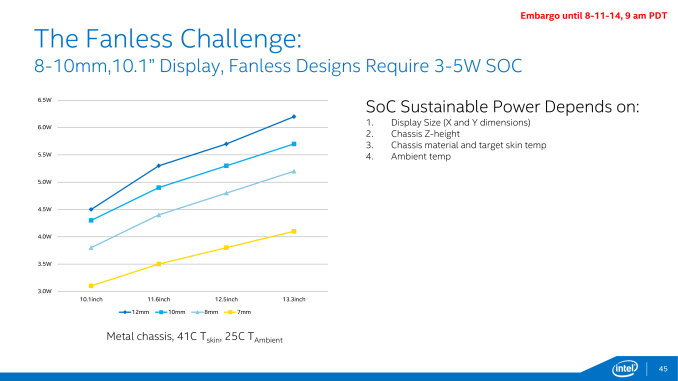
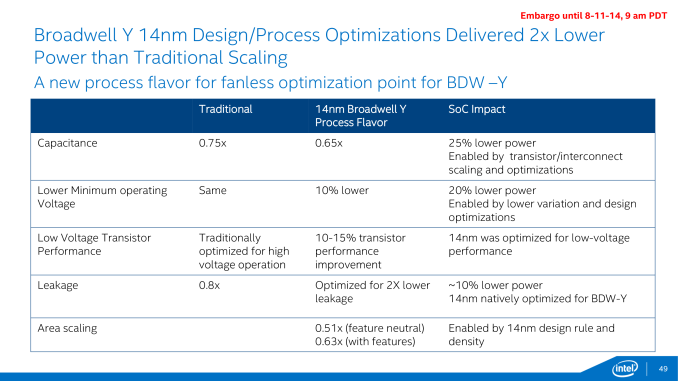
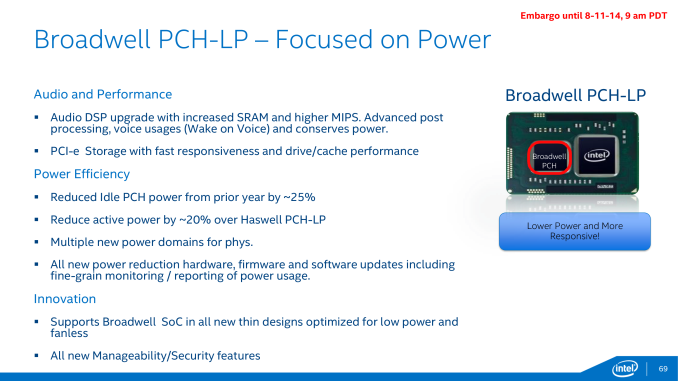
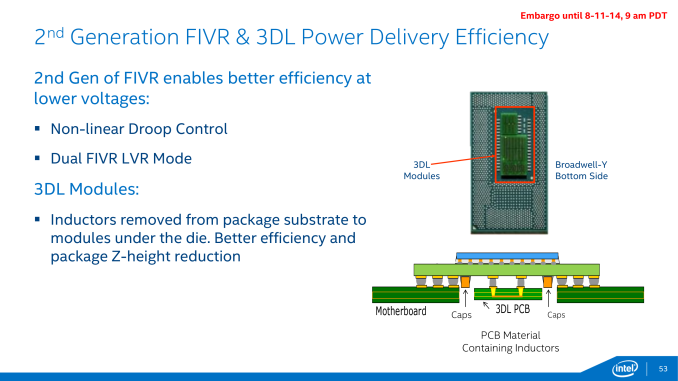

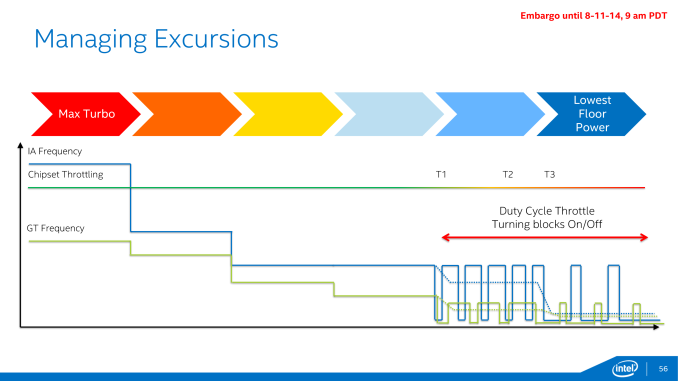








158 Comments
View All Comments
sherlockwing - Monday, August 11, 2014 - link
Tskin=41C?!? Is Intel out of their mind? Did they not read how much trouble iPad 3 got into for a Tskin of 33.6C? http://www.theguardian.com/technology/2012/mar/20/...I hope they/OEMs do keep Tskin undercontrol with better throttling when actually shipping these chips in products.
ZeDestructor - Monday, August 11, 2014 - link
People are cool with high TSkins on their devices. I know my phone passes 35°C easily if I load it up, and I'm fine with that. Then again, I'm completely fine with a 60°C idle, because that's where ICs like to live...Gondalf - Saturday, August 23, 2014 - link
Ummmm present iPad Air scores a 42.1°C skin temperature with an A7 running inside.So not a concern, all recent tablets are pretty hot.
magnusmundus - Monday, August 11, 2014 - link
Looking forward to seeing benchmarks and desktop 14nm parts.Also, I found a typo on the closing thoughts page "Though laptops at a category" should be "Though laptops as a category"
DanNeely - Monday, August 11, 2014 - link
I'm surprised they didn't move the PCH to 22nm. Relatively low power consumption or not, they pushed everything else to the wall to get Core M's TDP as low as possible and between doing custom designs for it anyway and soft sales meaning they've got the spare 22nm capacity available I don't see any obvious reason why they couldn't've done so.klmccaughey - Monday, August 11, 2014 - link
Vastly diminishing returns for the expense seem the most likely answer to that.mkozakewich - Thursday, August 14, 2014 - link
The process nodes are very expensive to produce, so they need to get as much life out of them as possible. Also, a new(er) process isn't going to have a high enough yield. 22 Might have worked, but I bet the older process gave them a better bang for their buck.Flunk - Monday, August 11, 2014 - link
I was thinking of buying one of these, but it sounds like the focus is still on TDP over all else so it looks like waiting to Skylake is the plan for anyone with Sandy Bridge or newer.klmccaughey - Monday, August 11, 2014 - link
Yup :( Is there no hope for us gamers?wurizen - Monday, August 11, 2014 - link
i think AMD is your hope. if you don't have a sandy bridge cpu or in phenom land, an FX series cpu is a great cpu that will hold one over until AMD updates their desktop FX series line of cpu's. i mean a 990FX mobo has all you need. i think pci 2.0 is still adequate for today's video cards so that doesn't really matter. even though on paper, intel has pci 3.0 and usb 5.0 (just kidding) and thunderbolt 9.9, they're superflous and doesn't make you game better. i mean, an fx-8350 with a decent gpu should give one smooth framerates. i mean who cares if in the benchmark, an fx-8350 with so and so gpu will run so and so game at, say 120fps, while an intel chip will run it at 190fps? 120 fps is like very good and that person who has an intel chip running 190 fps probably paid hundreds of dollars more for their system and i bet they wouldn't be even to decipher those 70 or so of more frames. i mean, it's not total fps that matters but the average frame rate and i think an fx-8350 will deliver that. it's a beast of a cpu. and broadwell? who cares. 90% of the words in the article above are buzz tech fancy words to get gadget heads salivating and stock wigs greasing their palms.